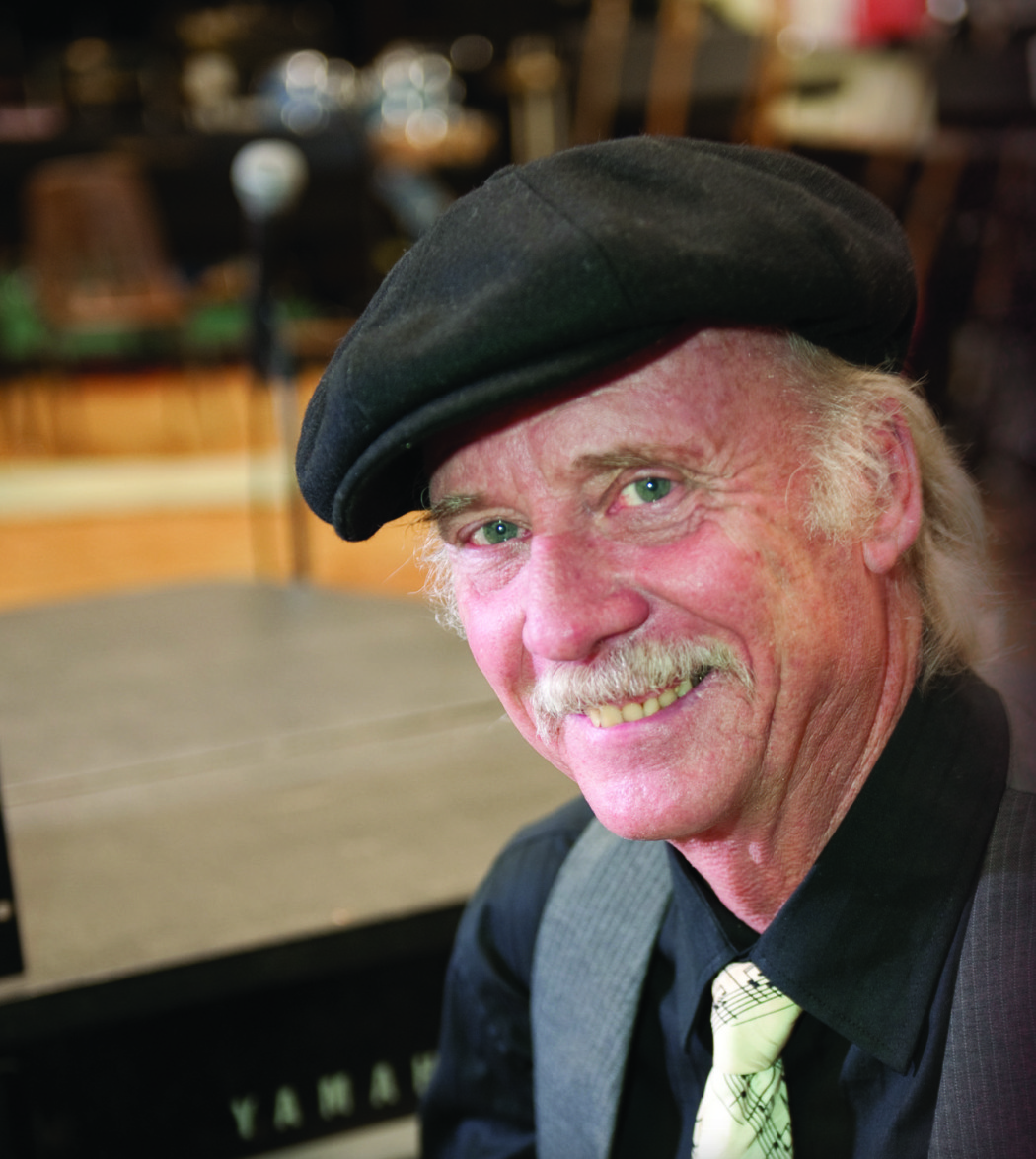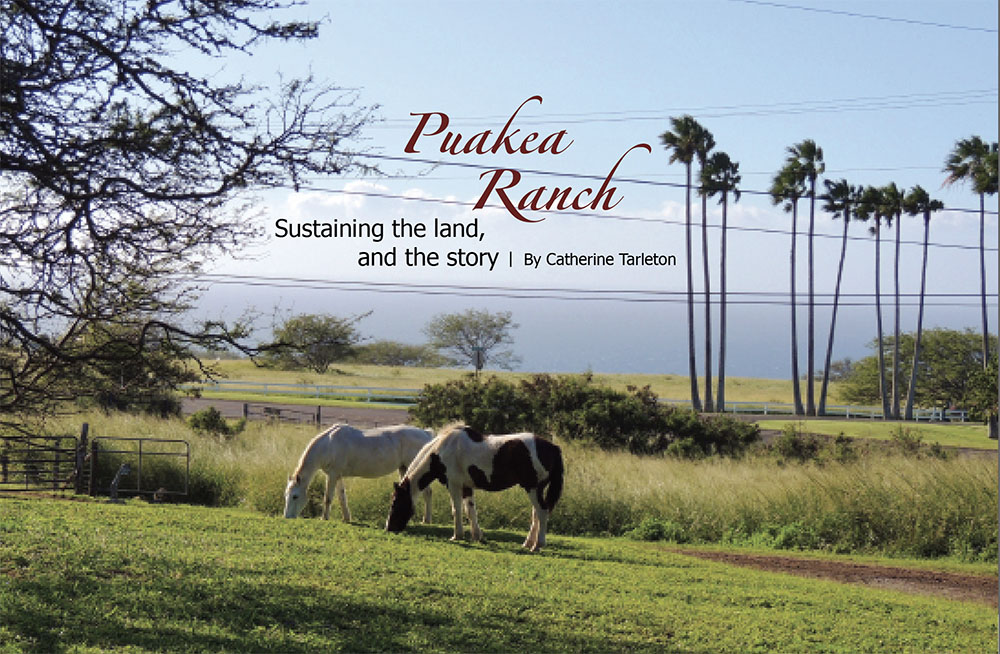
1500 Shades of Aunty Betty Webster
By Catherine Tarleton
Aunty Betty Webster and I are having lunch at a local restaurant. She walks in, grabs two menus, and sits in the first booth, facing the door. Aunty, Waimea’s official “sunglass queen” is sporting big bright yellow shades with pinup girls in the corners. Everyone who comes in smiles at her.

“Have a seat anywhere you like,” she says to a customer. “The menus are right there, and the girl will be with you in a minute.”
A German couple comes in, wife looking a bit nervous. “The restrooms are over there,” says Betty, always the hostess.
The waitress brings her a Pepsi, substitute for her preferred choice, Coca-Cola, one of what she calls her “five vices.” We order sandwiches and fries, and she changes sunglasses, stowing the pinup girls in their drawstring bag and pulling out a glittery gold pair she’s chosen to accessorize her outfit. Her eyes fill the double O’s in “COOL.” She’ll change a couple more times before we leave.
Betty has the world’s largest sunglass collection—1,506 to date, and growing. On October 2, 2015, she was awarded the Guinness World Records certificate proclaiming hers the largest collection of sunglasses in the world, and her achievement “Officially Amazing.”
1999
“I was working at the Bay Club, doing crafts, dancing hula, and teaching hula,” Betty says. “They hosted a New Year’s party for the guests and came up with these glow-in-the-dark glasses that said 1999. They had 2000 the next year, and I was working at Koa House Grill at that time. I called my niece and asked her to look in the computer and see if they have these funky glasses.”
Her niece certainly did find the funk, as did friends and family members, and a growing fan base, always on a hunt for the most unique and outrageous.
“I started wearing glasses as a conversation piece, just to make people smile, to make them laugh,” she says. “When I got to 500, I thought, ‘I want to get into the Guinness Book.’ And when I got 500, I thought I’d better go for 1,000.”
Betty worked as a hostess for some of Waimea’s favorite former restaurants: Koa House Grill, Daniel Thiebaut, Pakini Grill, and Tante’s, as well as Mama’s House Thrift Store.
“The customers would look for them and bring them or send them to me. I used to go to Vegas too, and the next thing you know I got to 1,000 in no time and said to myself, ‘I think I’d better go for 1,500.’”
She has them all—Elvis, Uncle Sam, monsters, and Minions. Some have windshield wipers that work. Some light up. Some are homemade for special occasions. Several are R-rated. One oddly artistic pair, covered in barnacles, was found by her son Barry at the bottom of the ocean.
“My goal is to get to 3,000. Because I’m 87 right now, I want to see if I can get it before I turn 90,” she says with a smile.
Small Kid Days
Betty Lei Maile Solomon was born on April 25, 1929, and raised in Kalihi on O‘ahu by her mother Mary Agatha Yap. Her father, Arthur Solomon, had joined the National Guard during WWII and was injured in France. “He saved his troop when a mine blew up. He was in Letterman’s Hospital in San Francisco for years. After his discharge from the military, he moved in with some friends because he did not want to be a burden for his family,” says Betty.

I asked if she remembered the attack on Pearl Harbor.
“I used to stay with my aunt, and we got 25 cents to put in the collection plate at church,” Betty recalls. “Somehow we always got change—dimes and nickels. Beretania Street had this okazuya (In Japanese, okazu is food with rice, and ya is store) with sushi, sweet potato, and things for five cents. When we came out [of the shop] we looked up in the sky and saw all these planes going over. We said ‘What are they doing? God is punishing us ‘cause we didn’t put all the money inside the collection plate!’”
“When we got to my aunt’s home, she said ‘Get in the house and close the door. Japan just bombed Pearl Harbor!’ Then we had to stand in line to buy poi.”
She learned to dance hula at age nine, when her mother took Betty and a cousin to classes taught by Kumu Hula Tom Hiona. They danced at the Royal Hawaiian Hotel in the 40s, when renown falsetto singer George Ka‘ainapau was performing there.
“I kept on dancing and dancing till I was older,” she says. “I danced at Waikīkī, at the Academy of Arts on Beretania Street, during the war at the USO, the YMCA. We went to different camps and performed for the soldiers.”
Her kumu had left O‘ahu when the war started, so she and some of her hula sisters went to Kumu Bill Lincoln. “He was a famous singer and hula instructor at the same time as Maiki Aiu was in the business,” says Betty.
Working Girl
Betty graduated from Maryknoll High School, Class of 1948, and went almost immediately to work at Pearl Harbor as a clerk. She worked her way up to being secretary to the “big chief,” the civilian in charge of her department.
“He had so many groups under him. All the trades, like pipefitters and welders,” says Betty. “When he retired, I saw all these ‘apprentices’ coming in and making more money than me, and I thought ‘there’s something wrong with this system.’ I told the outgoing boss I wanted to go into blue collar.”
“I became the Tool Room attendant for Shop 06,” she says. “I had to learn what they all were, but it didn’t matter. I knew a lot of the boys. Oh, I knew what a hammer was, but if it was something like a specific drill bit, I’d say, ‘You know what brah’, come this side and get it yourself.’”
On the weekend, she was in charge of all of the tool shops, and had to ride a bicycle between them. It was the only thing she didn’t like about her job.
“I would put it up against the building, hold it there and push off,” Betty says. “I had to wear a hard hat and safety glasses. The boys would see me and say ‘Hey Betty!’ and I’d say ‘Shut up.’”
One boy she did not tell to shut up was Jack Webster from Hawai‘i Island. They met on the volleyball court, on opposing teams. She doesn’t remember who won the game, however, she never forgot the tall, handsome Scotsman. It was love at first sight.
Not long after, Jack took a job picking strawberries in California. He went to see her father in the hospital, who afterward wrote to Betty. “He said, ‘Don’t marry him. He’s an alcoholic.’”
Betty says. “I wrote back to him, ‘It takes one alcoholic to see another one.’”
The two were married and raised four boys, Jack Jr., George, Barry, and Duane. The three oldest went to Kamehameha Schools.
“Duane is a surfer,” says Betty. “When he had his interview and they asked him why he wanted to go to school there, he said ‘I don’t; my parents do.’”
She proudly tells me that Duane now teaches autistic children to surf, traveling all over the East Coast. “I tell him, ‘You were meant to do that, even if you never went to Kamehameha School.’”
Changes
She and Jack talked about moving to Hawai‘i Island when he retired. They visited in 1996—when Betty retired after 33 years at Pearl Harbor—and he drove her to where his family had lived, Pāhala. Betty says she dozed off and missed it.
She had a sister-in-law in Waimea and Betty loved it there, even though Jack thought it was too cold. “I told him, ‘I ain’t living any other place but Waimea,’” says Betty. “I didn’t tell him I had arranged to put in a heating system.”
Jack had scheduled heart surgery in Honolulu later that year. Betty and three sons came to Waimea to transfer the Hawaiian Home Lands property and get it ready for Jackʻs arrival. Duane stayed in Honolulu. Tragically, Jack injured himself in the hospital; he suffered torn stitches and severe bleeding then went into a coma, and died about 3am.
It took Betty about a year to get back to Waimea. She was uncertain; felt like she had no friends there and nothing to do. Meanwhile, her son Jack had a position with Tupperware, and encouraged her to try selling the products to get out of the house and be with people. She had all kinds of reservations, but “Everybody was so nice, I got into the spirit,” she says. “They made me feel comfortable.”
Time passed, Tupperware sold, and Betty went to Waimea. She remembers looking at the yard, the grass overgrown into the flower beds.
“I worked in the yard little by little,” she says. “I cursed at my husband and said ‘look what you got me into. I never had to work in the yard before!’”
However, she kept at it, bringing the house in Kūhiō Village to life with her flowers, her little dogs, her collection of Coca-Cola memorabilia, stuffed animals, and eventually her sunglasses.
Good Young Days
Today Betty dances with Kumu Hula Buzzy Histo and Kalikokalehua Hula Studio. She’s a proud grandmother of five and great-grandmother of four. She volunteers at North Hawai‘i Hospice every week and goes to Las Vegas as often as she can. She’s also a breast cancer survivor since 2014.
After our lunch, she tells me she has a lot to do to get ready for the weekend. She’s going to O‘ahu to attend a lū‘au at her granddaughter’s law school, and her son’s hānai son Lance’s daughter’s wedding. That means different mu‘umu‘u (from her collection of 300) and assorted shades to coordinate with each outfit.
Before she goes, I ask if she has any advice for young women, just starting out.
“If kids nowadays are smart enough, they would try to continue school if they can,” she says. “If you can go to college, that’s great, you’ll have better opportunities to get a job.” She would also advise girls to enjoy being single for a while.
“Once you get married and have a family, that’s it,” Betty says. “You’re confined until the children get older, then you have to go look for a job, and what kind of skills do you have? Don’t raise a family yet, until you can get yourself established and have some kind of fun. Once you commit yourself, those good young days are gone.”
Somehow, I would bet Aunty Betty has plenty of good young days left—to collect her 3,000 sunglasses, and make people smile. ❖
Contact writer Catherine Tarleton: catherinetarleton@gmail.com


